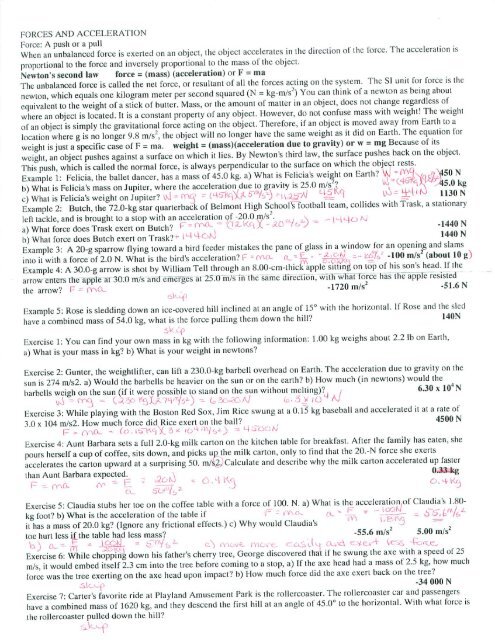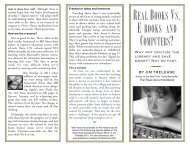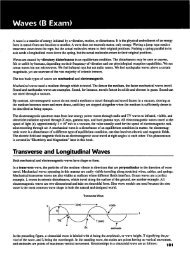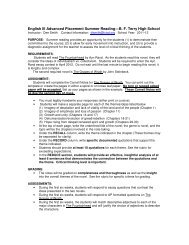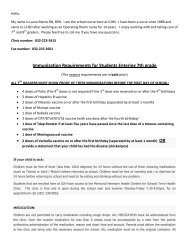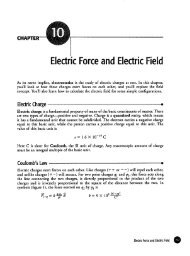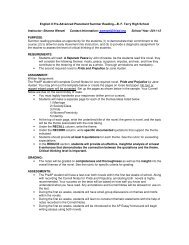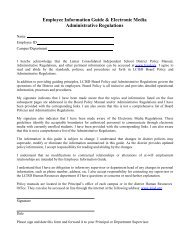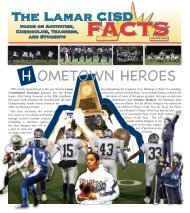a) What force does Trask exert on Butch? F - ^\ ~\⢠*
a) What force does Trask exert on Butch? F - ^\ ~\⢠*
a) What force does Trask exert on Butch? F - ^\ ~\⢠*
Create successful ePaper yourself
Turn your PDF publications into a flip-book with our unique Google optimized e-Paper software.
FORCES AND ACCELERATIONForce: A push or a pull , .When an unbalanced <str<strong>on</strong>g>force</str<strong>on</strong>g> is <str<strong>on</strong>g>exert</str<strong>on</strong>g>ed <strong>on</strong> an object, the object accelerates in the directi<strong>on</strong> of the <str<strong>on</strong>g>force</str<strong>on</strong>g>. The accelerati<strong>on</strong> isproporti<strong>on</strong>al lo the <str<strong>on</strong>g>force</str<strong>on</strong>g> and inversely proporti<strong>on</strong>al to the mass of the object.Newt<strong>on</strong>'s sec<strong>on</strong>d law <str<strong>on</strong>g>force</str<strong>on</strong>g> = (mass) (accelerati<strong>on</strong>) or F = maThe unbalanced <str<strong>on</strong>g>force</str<strong>on</strong>g> is called the net <str<strong>on</strong>g>force</str<strong>on</strong>g>, or resultant of all the <str<strong>on</strong>g>force</str<strong>on</strong>g>s acting <strong>on</strong> the system. The SI unit tor torce is thenewt<strong>on</strong> which equals <strong>on</strong>e kilogram meter per sec<strong>on</strong>d squared (N = kg-m/s2) You can think of a newl<strong>on</strong> as being aboutequivalent to the weight of a stick of butter. Mass, or the amount of matter in an object, <str<strong>on</strong>g>does</str<strong>on</strong>g> not change regardless ofwhere an object is located. It is a c<strong>on</strong>stanl property of any object. However, do not c<strong>on</strong>fuse mass with weight! The weighlof an object is simply the gravitati<strong>on</strong>al <str<strong>on</strong>g>force</str<strong>on</strong>g> acting <strong>on</strong> the object. Therefore, if an object is moved away from Earth to alocati<strong>on</strong> where g is no l<strong>on</strong>ger 9.8 m/s2, the object will no l<strong>on</strong>ger have the same weight as it did <strong>on</strong> Earth. The equati<strong>on</strong> forweight is just a specific case of F = ma. weight = (mass)(accelerati<strong>on</strong> due to gravity) or w = mg Because of itsweight an object pushes against a surface <strong>on</strong> which it lies. By Newt<strong>on</strong>'s third law, the surface pushes back <strong>on</strong> the object.This push, which is called the normal <str<strong>on</strong>g>force</str<strong>on</strong>g>, is always perpendicular to the surface <strong>on</strong> which the object restsExample 1: Felicia, the ballet dancer, has a mass of 45.0 kg. a) <str<strong>on</strong>g>What</str<strong>on</strong>g> is Felicia's weight <strong>on</strong> Earth? Vb) WhaL is Felicia's mass <strong>on</strong> Jupiter, where the accelerati<strong>on</strong> due to gravity is 25.0 m/s ? 45.0 kgc) <str<strong>on</strong>g>What</str<strong>on</strong>g> is Felicia's weight <strong>on</strong> Jupiter? \si - mg - t^W V f ^ 7 =Example 2: <strong>Butch</strong>, the 72.0-kg star quarterback of Belm<strong>on</strong>t High School's football team, collides with <str<strong>on</strong>g>Trask</str<strong>on</strong>g>, a stati<strong>on</strong>aryleft tackle, and is brought to a stop with an accelerati<strong>on</strong> of -20.0 m/s2 v _ mqo Ma) <str<strong>on</strong>g>What</str<strong>on</strong>g> <str<strong>on</strong>g>force</str<strong>on</strong>g> <str<strong>on</strong>g>does</str<strong>on</strong>g> <str<strong>on</strong>g>Trask</str<strong>on</strong>g> <str<strong>on</strong>g>exert</str<strong>on</strong>g> <strong>on</strong> <strong>Butch</strong>? F - <strong>^\</strong> ~\ *b) <str<strong>on</strong>g>What</str<strong>on</strong>g> <str<strong>on</strong>g>force</str<strong>on</strong>g> <str<strong>on</strong>g>does</str<strong>on</strong>g> <strong>Butch</strong> <str<strong>on</strong>g>exert</str<strong>on</strong>g> <strong>on</strong> <str<strong>on</strong>g>Trask</str<strong>on</strong>g>?+ i1"'Example 3: A 20-g sparrow Hying toward a bird feeder mistakes the pane of glass in a window for an opening and slamsinto it with a <str<strong>on</strong>g>force</str<strong>on</strong>g> of 2.0 N. <str<strong>on</strong>g>What</str<strong>on</strong>g> is the bird's accelerati<strong>on</strong>? F *
Name Period DateNewt<strong>on</strong>'s Third LawC<strong>on</strong>cept-DevelopmentPractice Page6-11. In the example below, the acti<strong>on</strong>-reacti<strong>on</strong> pair is shown by the arrows (vectors), and the acti<strong>on</strong>reacti<strong>on</strong>described in words. In {a) through (g) draw the other arrow (vector) and state the reacti<strong>on</strong>to the given acti<strong>on</strong>. Then make up your own example in (h).Example:c.l'Fist hits wall.Wall hits fist.Head bumps ball.Ball bumps head.Windshield hits bug.Bug hits windshield.Bat hitsball.Hand touchesnose.Hand pulls <strong>on</strong> flower.Ball hits bat.Nose touches hand.(e) Flower pulls <strong>on</strong> hand.Student drawing (open)Athlete pushes barupward.Compressed air pushesballo<strong>on</strong> surface outward./j^ Thing A acts <strong>on</strong>Thing B.Bar pushes athletedownward.(g).Ballo<strong>on</strong> surface pushescompressed air inward.Thing B reacts <strong>on</strong>Thing A.2. Draw arrows to show the chain of at least six pairs of acti<strong>on</strong>-reacti<strong>on</strong> <str<strong>on</strong>g>force</str<strong>on</strong>g>s below.VYOU CAN'T TOUCHWITHOUT BEING TOUCHEDNEWTON'S THIRD LAWc<strong>on</strong>ceptual©Addis<strong>on</strong>-Wesley Publishing Company, Inc. All rights reserved. Chapter 6 Newt<strong>on</strong>'s Third Law of Moti<strong>on</strong>—Acti<strong>on</strong> and Reacti<strong>on</strong> 27


